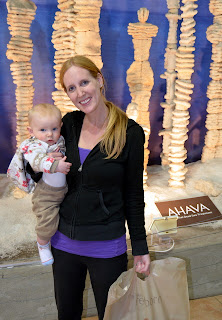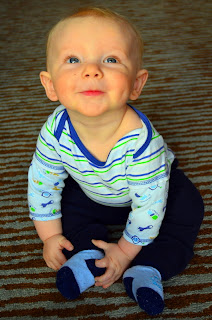With ten years (yes, 10!) of marriage under our belts, Nicki and I decided to head to the Dead Sea for a couple of days to celebrate. Having been there, we can now officially say that we’ve “got friends in low places”. At an elevation of 1388 ft below sea level, the Dead Sea is the lowest point on Earth. It is also one of the world’s saltiest bodies of water—with over 10x the amount of salt as the ocean. Oh, and the water contains lots of minerals, too.
Given the Dead Sea’s unique properties, and the fact that the area gets on average 330 days of sunshine (sunshine, mind you, that is less likely to cause sunburn given the elevation) per year—it attracts a lot of tourists. Many of them are Russian. These Russians, and the others, don’t just come for the Sea—they also enjoy taking pictures with camels, hiking in dry river beds called “wadis”, and visiting the cliff top ruins of Masada (see Dead Sea Day 2 – coming soon).
After gearing up (which included putting Sammy in his moose outfit), we left our apartment in Tel Aviv bound for the Dead Sea. On the way, we climbed the hills towards Jerusalem (elevation 2500’). From there, it was all downhill…a drop of almost 4000’ to the Dead Sea. The landscape changed drastically from forested hills to barren desert inhabited solely by shepherds.
Our first stop was at Qumran National Park, the site where the Dead Sea Scrolls were discovered. After being hidden for over 2000 years, a Bedouin shepherd inadvertently stumbled upon a set of scrolls in 1947—and the rest were found over the next 8 or 9 years. Much of the scrolls turned out to be copies of the Hebrew Bible (aka “Old Testament”) which, incredibly, showed that the books had not been altered over the years. Read more about the scrolls here.
Qumran is the first stop for many Dead Sea bus tours from Jerusalem. Given this, there is a large gift shop complete with “Ahava” brand beauty products (made with Dead Sea salt & minerals). Nicki wanted to check it out, so we did. After Sammy garnered attention from a sales lady, and the woman found out that we are living in Tel-Aviv and were not part of a tour group, she leaned in and whispered to us that we should NOT buy Ahava products at her store. They are, in fact, much cheaper at the Factory Store twenty minutes down the road. We appreciated her honesty, and figured take her up on the recommendation. After ten years of marriage, if there’s one thing I’ve learned, it’s not to turn down a good deal on beauty products.
Here’s little Sammy in an outfit from Grandma B. They both like moose!
This is our first camel spotting. This camel was located at the “sea level” turn-off about halfway between Jerusalem and the Dead Sea, luring tourists like us in for a 10-shekel photo op. We decided to take a rain check.
In addition to the Dead Sea scroll caves, the Qumran National Park also includes some ruins. Apparently the inhabitants liked dates.
Here’s one of the Qumran caves in which the scrolls were found.
And here’s a view of the Qumran ruins. Can you see some caves in the background?
Do you know these two? Nicki and Sam posing at the Ahava Factory Store. Those are Dead Sea salt sculptures in the background.
Finally, a literal “Factory Store”—complete with a factory! While I analyzed the manufacturing process, Nicki was busy shopping and Sammy wooed one of the sales ladies. Some of the manufacturing technicians also smiled at Sammy through the window.
Outside of the Ahava factory, we came across this plant. It had some soft and squishy bark, and an apple-like fruit. A man walked by while Nicki and I were studying it—and, in case he spoke English and couldn’t tell, I remarked “we’re not from around here”. He passed without a word. As he pulled away in his car, however, he paused, and out the window warned: “don’t eat it, it’s poisonous!”. We hadn’t planned on tasting this forbidden fruit, but got a kick out of his advice nonetheless. Later we found out that the plant is called a Sodom Apple.
We drove along the Dead Sea shore, but didn’t yet get out of the car to explore. Partly because the weather was gray and windy…and partly to avoid the sink-holes. The Dead Sea is a bit selfish, you see. It takes in water from various sources (see Jordan River), but doesn’t have any outflow. Thus, its size is determined by inflow minus evaporation. And, with much of the Jordan being diverted for irrigation, combined with many 100+ degree days, the evaporation is winning as of late. Given all of this, the Dead Sea is now just a fraction of its original size—which creates the potential for sink holes in the muddy areas which water once covered. You can read more about sink holes and the dire future of the Dead Sea here.
Camels certainly aren’t something we’re used to watching out for while driving. Just for the record, we only saw a few of them, and they were used as props by roadside shops to draw in business. None were crossing the road.
Here’s a salty rock formation they call “Lot’s wife” near Mt. Sodom. Based on some Google search results, this isn’t the only formation with the same name.
Can you guess what this is? Scroll down to find out…
Yes, it is a gigantic pile of salt having been harvested from the Dead Sea.
We spent two nights in Ein Bokek—a seaside tourist town on the Southern part of the Sea. Given our hotel room’s carpeted floors, Sammy was in heaven! He squirmed and rolled his way all over the room, making us realize that our tiled apartment floors need some carpet. Does he appear proud of himself for sneaking under this table, or what?
Have I mentioned that Sammy can sit by himself now? Here’s proof.

























